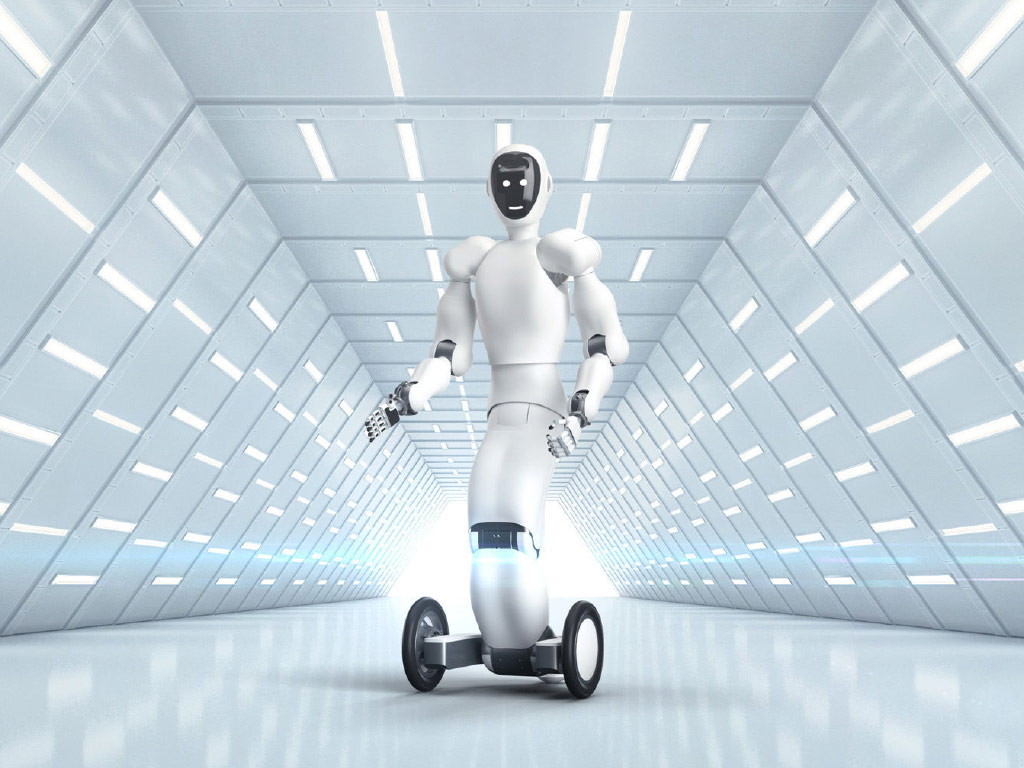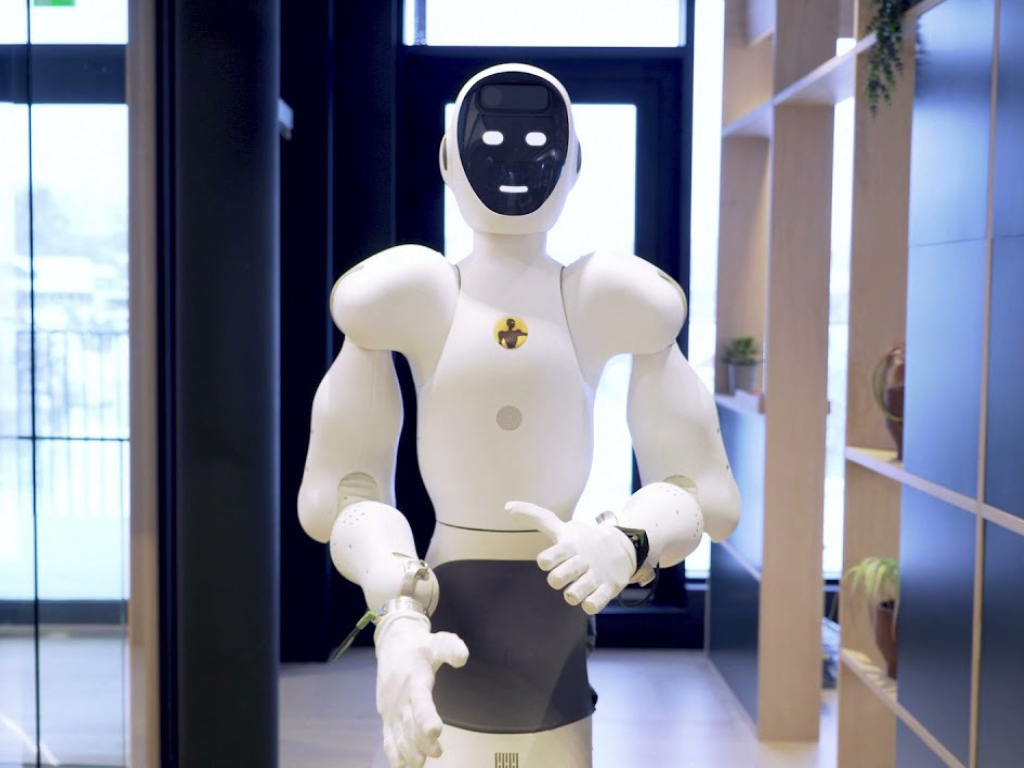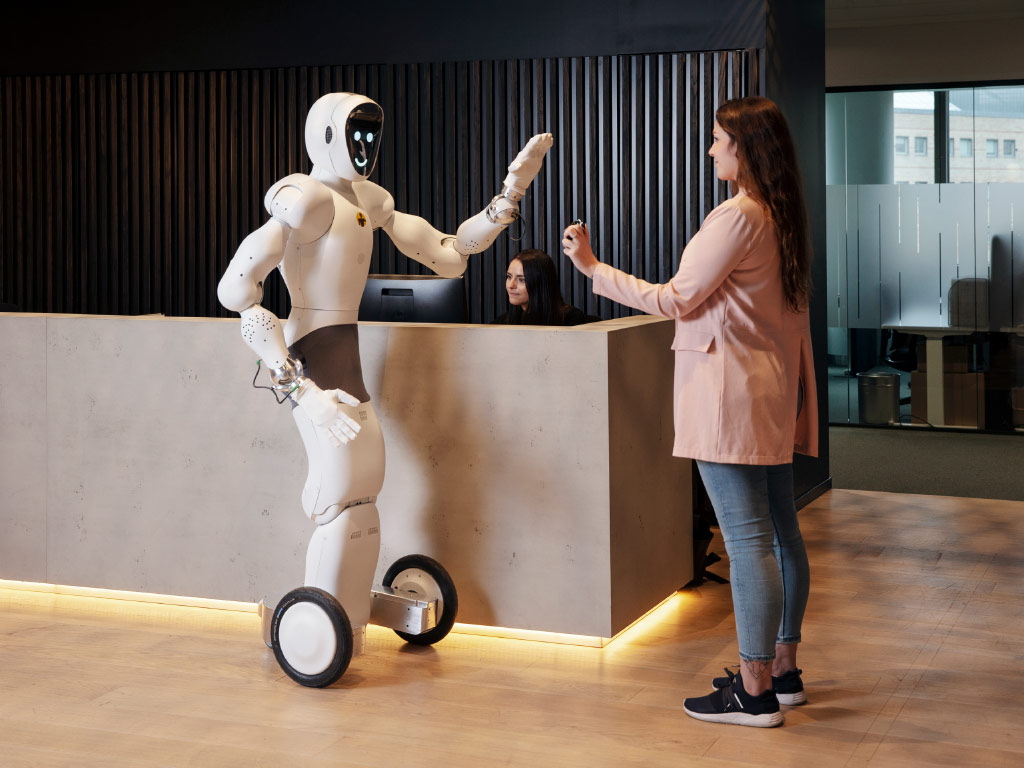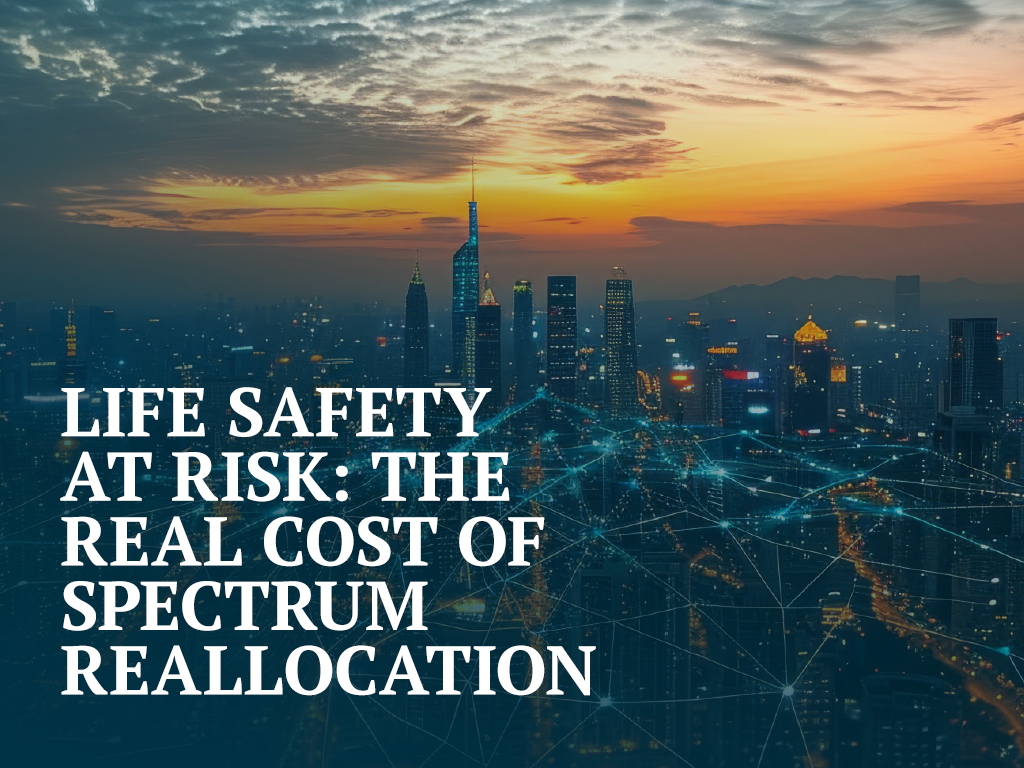Slowly Bot Surely

More robotic capabilities and cost-effective technology make 2022 the right time for humanoid robot security guards
Representatives from ADT Commercial sat in a video conference with one of the most important customers they’d had in a long time. The company had expressed interest in the pilot program for a new security product developed through a partnership between ADT Commercial and Halodi Robotics, a Norway-based company that builds humanoid robotic solutions. ADT Commercial was hoping to get their customer’s commitment to test a robot designed to complement their guard force, and they wanted to convey the value such a robot would have to security operations.
Just then, Gemini, a six-foot, human-shaped robot with an expressive emoji face, rolled into the room and said, “Hello.” The pilot program was an easy sell after that – “Our customer quipped at the end of the meeting, ‘You had us at hello,’” recalls Ed Bacco, Vice President of Enterprise Security Risk Group at ADT Commercial.
Three of ADT Commercial’s customers will be testing Gemini, the current Halodi robot prototype, in 2022; with two robots per site, they’ll have the opportunity to identify the benefits of the robots and make suggestions for further development. Dan Bresingham, Executive Vice President of ADT Commercial, is grateful for their participation. “These pilots are big, big companies who are willing to spend their time and energy to help us build this robot right,” he says.

Designing Gemini
Aside from being able to speak and having a human-like form, Gemini has upper-body joints with a wide range of motion, including hands that can grasp things.
“With the first handshake with the robot you realize it’s real. It feels like an actual human arm that you’re shaking hands with – very different from traditional industrial robots,” remarks Nicholas Nadeau, Chief Technology Officer of Halodi Robotics. “We’re getting to the point where the human-robot interaction, applied to the security domain, can be something that can disrupt the industry.”
The form of the robot was a design that involved great intention and research. The Halodi team didn’t want to risk venturing into “uncanny valley” – a term for the point where an object’s degree of resemblance to a human being evokes discomfort rather than empathy. Gemini’s emoji face, for example, is comfortingly familiar to humans rather than disturbingly mimicking a human face.
“We made the conscious choice to shape the robot like a human rather than R2D2 because humanoid robots let us access the world as humans do. Shaping a robot like a human lets the robot interact in the human environment,” which includes traveling in elevators, reaching shelves, and opening doors, explains Nadeau.
While testing the robot’s interactions in the world, ADT Commercial and Halodi have also tested the reaction of people interacting with the robots. “We look at how the robot will be received, and from there, understand how humans interact with the robot,” explains Chris Fowler, Director of Emerging Technologies at ADT Commercial.

Replacing Security Guards?
Trusting Gemini is a crucial part of Gemini being able to do its job well: the goal is to deploy it as an active member of a security team. Gemini has been designed to augment security guard operations, while collaborating alongside human employees.
“Anywhere you have a guard going through a facility to observe and report, we feel robots can do it better because a guard is only as good as a human being,” asserts Bresingham. “Human beings cannot do certain things that robots can do, such as look for heat or odor or analyze video or audio. And the robot’s operations can be standardized and audited. You can track the logs and verify that you’re meeting safety metrics, for example.”
Among other functions, Gemini can scan photo IDs, notice if appliances are overheating, and integrate with a human operator wearing a virtual reality headset. While human beings get tired, stressed, and distracted, fall ill, and make mistakes in judgement, Gemini doesn’t have any of those failings. The eventual goal is that it will be able to enter areas where there is smoke, fire, or hazardous materials, and potentially rescue people from those settings.
Security robots let human security operators work more efficiently, cover a greater area, and collect more data. Rather than merely provide video footage of an event that has already happened, they’re able to spot the sources of problems and relay data in real time.
“We live in a sensor-driven world, and we wanted to move the needle over to systems that have the ability to make sense of what is happening and actually do something about it,” Bacco explains. “When we perfect that, we want to move over to predictive analytics that can tell us what is about to happen.”
Adding robots on “staff” can also mitigate labor shortages – there were 10.4 million open jobs in the US in September 2021, the most recent month for which data are available. And because robots don’t take home paychecks or require health insurance, robots like Gemini can significantly reduce security cost while increasing security capability.

Breaking Down Barriers to Entry
Security robots were introduced at security trade shows years ago, of course: though we’ve known for a long time robots were coming, they always seemed more a flashy toy than reality. But 2022 is proving to be the right time to launch Gemini due to the ADT Commercial-Halodi partnership as well as advances in technology and end users’ comfort level.
“It would have been naïve of us as a pure robotics company to just jump into the security industry and say, ‘We have a solution for you: here are more robots and fancy technology,’” Nadeau comments. “The partnership with ADT [Commercial], who has domain expertise in security, lets us stay robotics experts and build the best solution possible and push the limits of what’s capable in security guarding.”
Bacco lists three things that have come together to make 2022 the right time for launching Gemini. The first is capability. Today’s robots are more capable than ever, which is a descriptor that covers even seemingly simple tasks like opening a door. Gemini can learn to open different kinds of doors with infinite different door handles.
“You think that’s easy,” he remarks, “but think about how when we were children, it took a while to learn how to operate a door.” Though capabilities such as these have existed for a while, “the next part is economics,” Bacco adds. “I like the way that other organizations’ robots dance but they’re also prohibitively expensive for most security operators.”
The third factor is acceptance: we are starting to accept robots and autonomous things as normal in our lives, from Roombas to autonomous cars.
Winning acceptance from end users starts with listening to their needs and managing expectations, says Fowler. ADT Commercial and Halodi received requests from their pilot partners and made adjustments for them, showing them that their input mattered.
“It was an evolution to introduce our pilot partners to the robots,” he notes. “They saw the potential and the opportunity to help develop something that would make their lives better, easier, and more cost efficient. We established a relationship with them over several months and were completely transparent about the robot’s capabilities, then introduced them to the physical robot.”

Building for Environments, Not Verticals
Which vertical markets are best suited for security robot deployment? It’s not the verticals, but the environments, Fowler says. “We look at the security needs in the environment, develop basic capabilities, and put them into that environment that supports what the customers need. Then we get feedback and build it into future R&D, so we can evolve over time to look at different environments.” This includes those with hazardous materials, nighttime requirements, or all-weather settings.
“This is a long-range plan,” Bacco adds. “Our future designs are being enriched right now by the insights we’re collecting from the pilot partners. The bots that we see today are going to be completely different in 24 months.”
With input from the pilot program and from future customers down the line, ADT Commercial and Halodi Robotics are poised to iterate new versions of Gemini that will help transform security as we know it. Slowly but surely, the security industry will become fully centered around stopping problems before they start rather than merely mitigating the chance a problem will occur.




